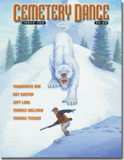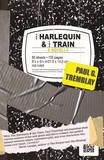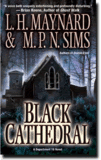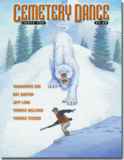“The Devil Came to Mamie’s on Hallowe’en” / Lisa Morton
 from Cemetery Dance #60 / May 2009
from Cemetery Dance #60 / May 2009
Reviewed by: Anthony J. Rapino
I once read that the two most important lines of a story are the first and last. If this is true, “The Devil Came to Mamie’s on Hallowe’en” starts beautifully with a whopper of a first line: “It was Hallowe’en night, and business was slow at the whorehouse.”
We meet Leona, a levelheaded sixteen-year-old who plays piano and sings for Mamie’s whorehouse. While everyone around her is superstitious, Leona remains unconvinced that Jacky-Ma-Lantern is wandering around on Hallowe’en night. Or that a hoodoo man is capable of bringing a dead boy back to life. So when Lizzie – a fellow working girl who fails to return before sunset and eventually shows up bloodied and stinking – claims to have summoned the devil himself, Leona is not fooled.
Lizzie explains that the devil granted a wish for her, and that a handsome, rich man will come to take her away that very night. Leona’s grip on reality is shaken when a man does show up with a marriage proposal for Lizzie, and her strength is further tested when her own dreams are offered for the taking.
Morton excels at creating a rich setting for her characters to take root. She carefully weaves superstitions and folktales into the narrative, all the while creating a new story from their ashes. Like Robert Johnson meeting the devil at the crossroads, Morton’s own telling feels as if it could have happened just as she describes.
Purchase Cemetery Dance #60 with “The Devil Came to Mamie’s on Hallowe’en” by Lisa Morton.
The Harlequin & the Train / Paul G. Tremblay
 Necropolitan Press / June 2009
Necropolitan Press / June 2009
Reviewed by: Vince A. Liaguno
“Lots of stuff happens without us knowing or hearing about it,” one character says to another at the beginning of The Harlequin & the Train. “And the worst part is sometimes it happens because of us and we don’t even realize it.” So begins Paul G. Tremblay’s surrealistic exploration of choice versus chance in this breathtaking new novella, an expansion of his 2003 short story of the same name that first appeared in Of Flesh and Blood magazine. With emotional shades of last year’s masterful Miranda by Stoker Award-winner John R. Little, The Harlequin & the Train plays out on the page like a Final Destination film directed by David Lynch.
When a crowded commuter train en route from the Massachusetts suburbs to Boston strikes what at first glance appears to be a person standing on the tracks (or a “jumper” as one of the veteran conductors earlier refers to the suicidal who choose railway as their means of self-annihilation), rookie engineer Rudy is cast into a surreal nightmare. The person turns out not to be a person at all, but rather a harlequin clown stuffed with meat and set upon the tracks by a group of seemingly ordinary people who appear to be laying in wait for the accident at track’s edge. Why they’re there and their subsequent shocking and inexplicable actions are at the root of Rudy’s nightmarish descent into a bizarre subculture in which the line between activity and passivity is thinner than one might think. In the process, Tremblay takes the reader on a metaphorical train ride of their own through his increasingly dreamlike landscape, each successive page adding momentum and propelling the narrative forward like an unflinching literary locomotive that plows through anything standing in its way. It’s an uncomfortable ride at times, and by trip’s end, the reader won’t even be sure they’ve arrived at their destination. But, then again, Tremblay’s clearly all about what’s unearthed along the journey, not the destination.
The Harlequin & the Train plays on our public fascination with tragedy and society’s collective vulture-like picking at the unfortunate carcasses we’re witness to on the evening news. Tremblay takes the idea of slowing down to gawk at an accident scene to an entirely new level, transforming our involvement from merely voyeuristic to participatory – here in the form of a yellow highlighter. Indeed, Tremblay has positioned himself as something of a virtuoso when it comes to the intricate, interactive narrative format – as also evidenced by last year’s sublime “The Blog at the End of the World” (winner of DSM’s Black Quill Award for short fiction).
Thematic complexity and interactivity aside, The Harlequin & the Train is notable for Tremblay’s superb prose, which is somehow both economical and lush at the same time. His sentences are like the finest cut of meat, trimmed by a master chef with the sharpest of knives so as to excise every bit of fat without losing an ounce of the succulent meat. There’s not a wasted word to be found here, each giving the impression that it has been handpicked, held up to the light and examined, and placed in precisely the right spot by the author. Even his descriptions of mundane routine – in this example, a character’s daily commute to work – crackle to life with energy and precision of detail:
There’s a full house of commuters on the train. The passenger car is filled with folding and unfolding newspapers, iPods and headphones, and the tangy smell of the collected cologne and perfume of the passengers.
The conductor yells, “All aboard.”
The fat businessman doesn’t think about the quaint phrase, or how he used to wait for it like an expectant kid on Christmas morning when he first commuted to Boston almost twenty-five years ago. It used to mean something to him, a magic command, a manifest destiny call to railway travelers that hasn’t changed in over one hundred and fifty years. But for the businessman, such romantic notions are now as dead and forgotten as the laborers upon whose backs the railway system was built.
The businessman walks sideways up the aisle, squeezing past people until he finds a seat near the very front of the car. He sits heavily and checks his watch. The train blows its whistle and eases into a slow roll. Momentum is sometimes hard to achieve.The businessman offers to no one in particular a quick but triumphant smirk as he joins his fellow commuters in the ritual opening of his newspaper.
Tremblay has been establishing himself over the past several years as one of an up-and-coming crop of genre writers bringing the literary back into dark genre literature, one of whom challenges readers without losing entertainment value and one who entertains without dumbing the challenge down. The Harlequin & the Train is a heady trip down a surrealistic railway, making station stops at terror, paranoia, heartbreak, and – ultimately – truth.
Purchase The Harlequin & the Train by Paul G. Tremblay.
Black Cathedral / L. H. Maynard & M. P. N. Sims
 Leisure Books / January 2009
Leisure Books / January 2009
Reviewed by: Joan Turner
Black Cathedral, the third Leisure novel and the best to date by the long time writing duo of Len Maynard and Mick Simms, is a fast-paced, exciting ride that will keep readers turning pages until the end.
An atmospheric and character rich ghost story, Black Cathedral introduces Department 18, a special unit of the British government dealing with paranormal activities, and its members as they work to solve the strange disappearances on Kulsay, an island off the Scottish coast. A group of mid-management employees from Waincraft Software have gone missing while on a weeklong team building course on the island as well as the pilot and helicopter sent to rescue them. Not a clue to their whereabouts or the helicopter’s wreckage has been found.
A private company with a secret interest in the outcome finances the investigation.
Led by Jane Talbot, a woman whose marriage and personal life have come unraveled, the team includes four sensitives with special skills. One of the members, brilliant but troubled Robert Carver, is a man Talbot has romantic ties with from the past. Carver is a loner whose assistant also mysteriously disappeared on his last investigation and he has reason to believe the two cases are linked.
The team sets up shop in the ancient manse on the desolate island, and soon afterward strange psychic phenomenon begins. By the next morning, the situation has deteriorated into violent manifestations that leave one team member dead and Talbot missing. With contact with the outside world cut off, those remaining are left on their own to confront whatever horror awaits them.
In a story involving the eternal struggle between good and evil, an ancient evil rises to unleash devastation upon those who stand in its way.
Calling to mind Shirley Jackson’s The Haunting of Hill House and Anne Rivers Siddon’s The House Next Door, The Black Cathedral is a delicious and chilling treat for ghost story aficionados, proving once again that good horror fiction depends more on good storytelling than copious amounts of gore.
Despite a few clichés, Maynard and Sims succeed in delivering a riveting story, providing enough twists and turns in this well paced tale to keep the reader in suspense until the final breathtaking confrontation.
The authors have been a writing team for the past thirty-five years. They edited and published the anthology Enigmatic Tales as well as Darkness Rising. They have written numerous short stories and their latest collection, Falling into Heaven, was released in 2004. Previous Leisure novels include Shelter and Demon Eyes.
Black Cathedral is an impressive first novel in the Department 18 series. Well written and satisfying, it ranks as one of the best literary horror novels of the year to date.
Purchase Black Cathedral by Maynard & Sims.
“The Woman in the Club Car” / Thomas Tessier
 from Cemetery Dance, Issue #60 / May 2009
from Cemetery Dance, Issue #60 / May 2009
Reviewed by: Anthony J. Rapino
From the first sentence of “The Woman in the Club Car,” the reader knows where they are headed; it is in the title after all. And maybe for this reason the first few chapters initially seem like a diversion. We meet Phil, who is having lunch in Manhattan with his literary agent. Phil is feeling older. He’s recently divorced, doesn’t like his new life in Connecticut, and has trouble selling his articles.
Of his writing, Phil thinks, “Attention Spans are dropping, people want more instantaneous, impressionistic writing.” While this line refers to Phil’s drop in sales, one also infers Tessier’s allusion to his own feelings on the state of readership, and possibly this story’s slow start.
After a night of heavy drinking, Phil arrives at Grand Central and enters the club car where he meets Rachael. Through conversation more back story comes to light, and the first paragraphs are seamlessly tied into the larger story, dissolving the notion of a diversion.
Although the sense we know where the story is headed never alleviates, there’s an undeniable pleasure in reading it. The atmosphere Thomas Tessier creates leaves the reader enchanted, invoking a rare moment when you forget you’re outside the story and become a silent observer within it.
As the last line unfolds, many questions linger. The first reaction is to flip back to the first page and experience the story once again. The second is to write to Mr. Tessier and politely request a novel based on his story. The characters are fleshed out so well, it’d be a disservice to imprison them within this single short tale.
Purchase Cemetery Dance #60 with “The Woman in the Club Car” by Thomas Tessier.
Cover / Jack Ketchum
 Leisure Books / June 2009
Leisure Books / June 2009
Reviewed by: Martel Sardina
One of the most frequently asked questions a writer gets is “Where do you get your ideas?” In the Foreword to Cover, Ketchum answers that question as it applies to this book. The short answer is from a segment on the HBO documentary series, America Undercover. Ketchum saw an interview with a Vietnam Vet who lived out in the woods because the horrors of war made it unsafe for him to be around other people. The Vet is married and his wife has stayed with him despite the risk to her own life because she is certain that if she leaves he will die out there. The wife’s words haunted Ketchum, dredging up old feelings about the war and new ones about what it would be like to try and live a life without love.
In Cover, Ketchum introduces us to Lee Moravian, a Vietnam Vet who lives out in the woods with his wife, Alma, their son, Lee Jr. and faithful dog, Pavlov. While Lee generally refers to Alma by name, Ketchum shows the reader that Lee disassociates from his son and his loyal companion, by calling them simply, “the dog” and “the boy.” Lee earns a living by growing and selling marijuana to McCann, a fellow Vet that he’s known since their days in basic training.
McCann warns Lee that a thief is on the loose. Someone has been snooping around the forest and stealing pot plants from one of their other compadres. The thief hasn’t hit Lee’s stash, but the McCann’s warning has put Lee on guard. A new wave of paranoia is about to set in.
Meanwhile, Kelsey is man many would envy. He has money, good looks and two women who love him. This wouldn’t be as big of a problem if Kelsey were single. And while his wife of nearly twenty years, Caroline, is well aware of his relationship with Michelle, the general public might not be as understanding. Kelsey is a writer. Michelle is a model. If the press gets wind that the two are involved, it could be bad for both of them career-wise. Their “cover” will be blown especially if anyone learns that Michelle is pregnant.
Kelsey decides to take the girls and a few other friends out for a weekend camping trip. All is going well until the group discovers Lee’s stash while hiking. They are unaware that Lee is watching. Lee assesses the group and determines that they are a threat to his livelihood. He remembers his days in Vietnam and how even the seemingly innocent could not be trusted. It’s time for Lee to turn hunter. Kelsey and company are his prey.
Lee’s descent into madness is filled with flashbacks of his Vietnam experience. While the scenes are brutal, Ketchum is able to show readers how Lee has been shaped by the war. Readers can’t help feeling empathy for Lee. Ketchum doesn’t excuse Lee’s behavior (then or now) but makes him honestly face what kind of man he’s become.
Ketchum went to great lengths make Lee authentic, giving readers an in-depth look at the mental degradation many Vets suffered upon their return to civilian life. And as far as the question of whether or not it’s possible to live a life without love is concerned (a theme that comes up from time to time in his works) Ketchum proves once again that it is not.
Purchase Cover by Jack Ketchum.
Starkweather Dreams / Christopher Conlon
 Creative Guy Publishing / June 2009
Creative Guy Publishing / June 2009
Reviewed by: Martel Sardina
If “true crime” poetry wasn’t a genre before, it is now. And Christopher Conlon may well be its master. In 2007, I had the pleasure of reading Conlon’s Mary Falls: Requiem for Mrs. Surratt, a poetry collection based on the co-conspirator in the assassination of Abraham Lincoln. Part of the appeal of reading that collection was the opportunity to learn about a lesser-known figure in American history.
Now, Conlon presents readers with the opportunity to learn about the life of Charles Starkweather, a notorious spree killer who was executed in 1959. Starkweather was responsible for the murders of eleven victims and the corruption of Caril Ann Fugate, his underage girlfriend and partner in crime.
Conlon’s collection is hard to read due to the visceral response it is intended to cause. The images presented are not for the faint of heart. Sometimes Conlon describes the acts committed, but it is not an attempt to be sensational or gratuitous. Each poem is savage and brutal in its own way. “Sputnik” and “Slow Learner” are heartbreaking illustrations of a young girl’s (Fugate) struggle to understand why she is no longer worthy of her mother’s love. “First Sight” and “Loving Charlie” show a tender side of the couple. The juxtaposition of tender moments and intense violence is surprising in some ways. Though murder can be a crime of passion, it is still hard to believe that people who are capable of committing violent acts are also still able to love and be loved.
Readers who have the fortitude to withstand moments of longing, heartbreak, anger and despair will come away from the experience appreciating Conlon’s effort to delve deep and examine the relationship between Starkweather and Fugate, and the mental digression that led to these horrendous crimes.
Purchase Starkweather Dreams by Christopher Conlon.
Killing Red / Henry Perez
 Pinnacle / June 2009
Pinnacle / June 2009
Reviewed by: Martel Sardina
Alex Chapa’s reporting career took off the day that Annie Sykes, a missing ten-year-old girl, escaped from her captor, Kenny Lee Grubb. The girl led police back to his home where they made a shocking discovery. Grubb wasn’t your run of the mill crook. He turned out to be one of the most prolific serial killers the world had ever seen.
Nearly twenty years later, Grubb is less than a week away from being executed for his crimes. Chapa is assigned to do a death row interview. Since he broke the story, it only seemed fitting to give him the opportunity to follow the story full circle and perhaps finally gain closure on the Sykes case.
Grubb has other plans for Chapa where this interview is concerned:
“If I tell you the truth, will you print it?”
“We always print the truth,” Chapa said picking up the only pen that was still sitting on the table.”
“The hell you do. If you did, all of those sleepwalkers out there would take up arms and fortify their homes.”
“Would they?”
“You bet they would. Because the truth is, my work continues. Right now, just beyond these walls.”
Grubb reveals that another killer is on the loose. Someone is out there paying tribute, recreating Grubb’s greatest hits. Before Grubb dies, his disciple will deliver the greatest gift of all—the death of the girl who got away, Annie Sykes, the one Grubb called “Red.”
Once Chapa verifies Grubb’s claims, he must find Annie and prevent Grubb’s accomplice from carrying out his plan. It won’t be easy. Cops and reporters don’t always see stories from the same angle. Over the years, Chapa’s relationship with local law enforcement has become strained. While he does have one good friend on the force, Chapa is in danger of ruining that friendship by withholding evidence in order to keep Grubb’s bombshell from being scooped by a rival reporter. On top of everything else, Chapa’s been warned that if the piece on Grubb isn’t top notch, it may be his last.
Killing Red is Henry Perez’s debut novel. It stands out from similar novels in the genre for a couple of reasons. First, Alex Chapa is authentic. Perez took great care in giving readers a character with real feelings. Chapa regrets not having a better relationship with his own daughter. He knows that he’s sacrificed family for the sake of his career whether he intended to or not. Saving Annie isn’t just about stopping a crime from happening; it’s about Chapa redeeming himself for failing as a father. Second, Chapa’s insights on the newspaper industry, what a reporter’s job entails, and the future of a seemingly dying medium can be traced back to Perez’s own experiences as a journalist. Chapa has a passion for the news that wouldn’t be as pronounced if he’d been written by someone who didn’t have Perez’s background.
Many times, authors choose to alternate between the cop and the serial killer in this sub genre. Having a reporter as the main POV character gives readers a fresh perspective on a plot that some would argue is overused. Much of this reviewer’s enjoyment came from Chapa’s reactions to the events as they happened. The more you read a particular genre, the harder it is to be surprised. Perez scores points for writing a fast-paced, exciting story, with a couple of bonus points for the red herrings.
If you enjoy Killing Red, consider checking out Floaters, a novella in which Perez and Chapa team up with J.A. Konrath and his series character, Lt. Jack Daniels, to figure out why dead bodies keep turning up in the Chicago River. Floaters is currently available in the print anthology Missing: A Mysterious Gathering of Tales, edited by Amy Alessio (Echelon Press) or as a standalone novella for the Amazon Kindle.
Purchase Killing Red by Henry Perez.




